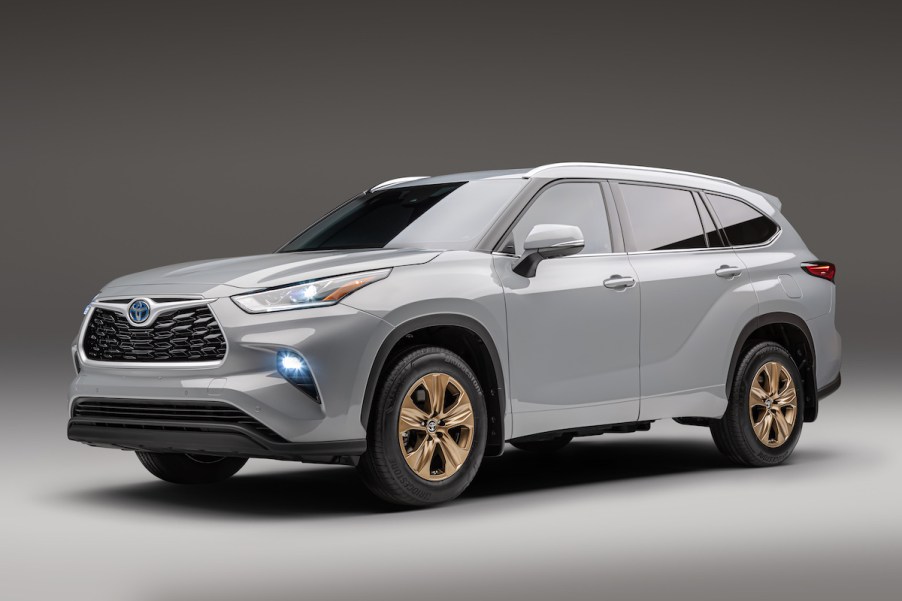
2022 Ford Explorer Only Has 1 Advantage Over the 2022 Toyota Highlander
In the market for a full-size three-row crossover? Well, the 2022 Ford Explorer and 2022 Toyota Highlander are popular choices. Even though different companies manufacture them, their performance and features are relatively similar. When it comes down to it, the Ford Explorer really has only one advantage over the Toyota Highlander.
A look at the 2022 Ford Explorer
The 2022 Ford Explorer comes in a range of trims that meet any need. The base model (along with the XLT, ST-Line, Limited, and Timberline trims) comes with a 2.3-liter turbo-four that generates 300 hp and 310 lb-ft of torque. RWD or AWD is available, and the fuel economy numbers are respectable for a vehicle this size, coming in at 20-21 mpg in the city and 27-28 mpg on the highway.
A Limited Hybrid version pairs a 3.3-liter V6 with an electric motor system that produces 318 hp and 322 lb-ft of torque, respectively. And if you opt for the ST, Platinum, or King Ranch, you’ll get a 400 hp-producing 3.0-liter turbo V-6 engine. Each powertrain comes with a 10-speed automatic transmission.
Each also comes with a generous assortment of comfort and tech features. The base model includes a power liftgate, a six-speaker sound system, an 8.0-inch infotainment touchscreen, and a three-zone climate control. Move up to the highest trim, and you’re treated to amenities like wireless device charging, a heated steering wheel, heated front-row and second-row seats, and more.
What the 2022 Toyota Highlander brings to the table

The 2022 Toyota Highlander is also a great option, with a standard 3.5-liter V-6 engine for all trim levels. FWD drive models get 21 mpg in the city and 29 mpg on the highway, while AWD models get a little less (20/27 mpg city/highway, respectively). The standard engine delivers 296 hp and 263 lb-ft of torque and comes with an eight-speed automatic transmission.
Inside the Highlander, you’ll also find an 8.0-inch infotainment touchscreen, although here, it’s accompanied by a 4.2-inch gauge cluster display. The base model also features three-zone automatic climate control, Wi-Fi hotspot capability, and several other amenities.
Moving up to the Platinum, the Highlander’s top-level trim adds unique exterior styling, ambient interior lighting, a 12.3-inch touchscreen, a 7.0-inch gauge cluster display, a power moonroof, and more. You can also outfit higher-level trims with optional features, like a premium 11-speaker sound system, and digital rearview mirror, among others.
The 2022 Ford Explorer offers greater comfort and utility
The two models are similar. Both have comparable technology options that come standard with various trims or can be purchased as optional upgrades. They also have comparable advanced safety systems: Ford through its Co-Pilot Assist+ package and Toyota through its Toyota Safety Sense 2.5+ package. And both offer extremely similar performance, handling, and fuel economy.
But inside, you’ll find the Explorer offers more space than the Highlander. There are 18.2 cu-ft behind the third-row seat, 47.9 cu-ft with that seat folded down, and 87.8 cu-ft with both the second and third-row seats folded down. The Highlander only offers 16, 18.4, and 84.3 cu-ft, respectively.
The Explorer’s interior design is also a bit more attractive than the Highlander’s, even on lower-level trims. Seat comfort is comparable in both, with the third row of each really better suited for children than adults. But the Explorer does have the Highlander beat when it comes to cargo space.
Toyota Highlander’s other advantages
This isn’t to say that the Explorer should be your default choice because it’s virtually identical to the Highlander in all other respects besides its superior cargo space. In fact, the Highlander is more affordable than the Explorer, according to JD Power. Though its starting MSRP of $35,405 is higher than that of the Explorer ($33,745), its top-level trim is more expensive ($53,995 for the Explorer compared to $47,560 for the Highlander. Ford also offers fewer connected services and charges more for them.
Toyota also has slightly better warranty coverage, especially for Hybrid drivers. If you buy one, you’ll get eight years or 100,00 miles of battery warranty coverage from Ford in most states and 10 years or 150,000 miles from Toyota. If you live in a state that follows California emissions standards, Ford will offer the same battery warranty coverage as Toyota, but Toyota makes that coverage standard no matter where you live.
Toyota also offers complimentary scheduled maintenance for the first two years after purchase or the first 25,00 miles, whichever comes first, while Ford does not offer any complimentary scheduled maintenance.
Choosing between these two vehicles will come down to buyer preference, as even with their differences, they’re still pretty similar in most respects. And both are great options for those in the market for a three-row SUV.


